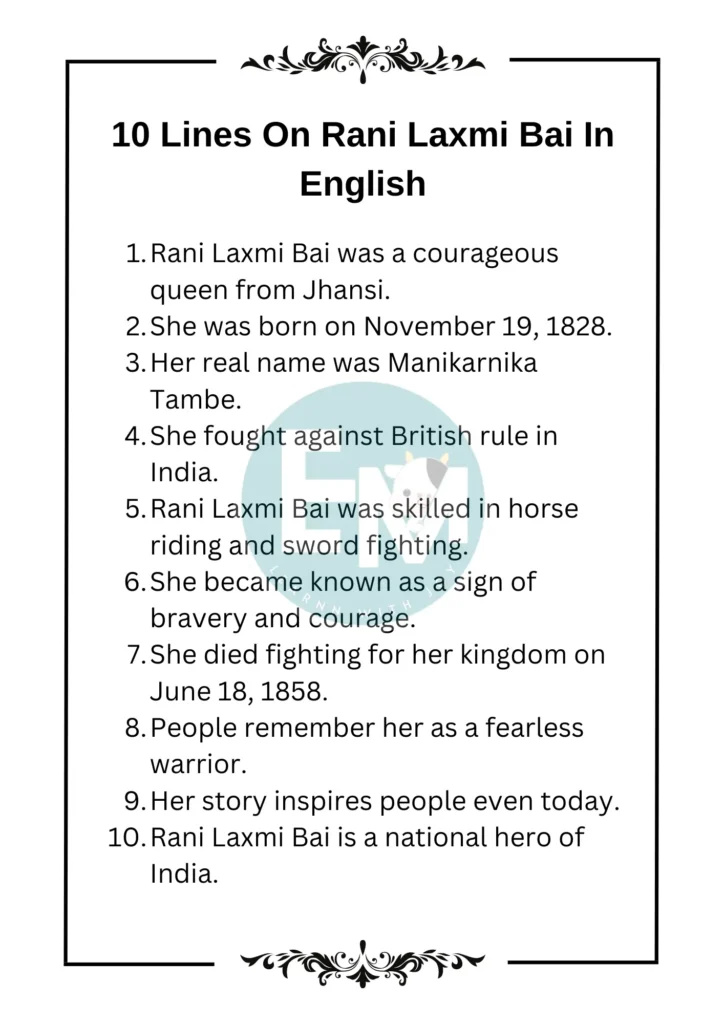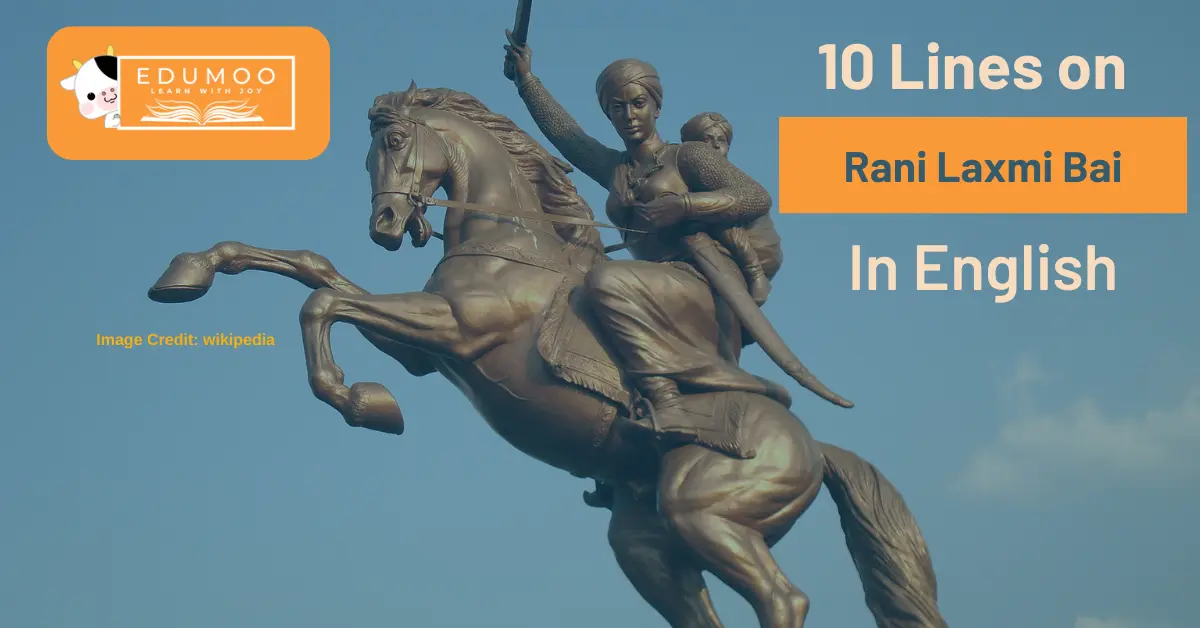Rani Laxmi Bai, a legendary figure in Indian history, continues to inspire generations with her unwavering courage and leadership. Born as Manikarnika Tambe on November 19, 1828, in Varanasi, she later became the Queen of Jhansi. Her defiance against British colonial rule during the Indian Rebellion of 1857 elevated her to the status of a fearless warrior. These 10 lines on Rani Laxmi Bai delve you into her remarkable life, shedding light on her pivotal role in India’s struggle for independence.
10 Lines On Rani Laxmi Bai In English
- Rani Laxmi Bai was a courageous queen from Jhansi.
- She was born on November 19, 1828.
- Her real name was Manikarnika Tambe.
- She fought against British rule in India.
- Rani Laxmi Bai was skilled in horse riding and sword fighting.
- She became known as a sign of bravery and courage.
- She died fighting for her kingdom on June 18, 1858.
- People remember her as a fearless warrior.
- Her story inspires people even today.
- Rani Laxmi Bai is a national hero of India.

Essay On Rani Laxmi Bai In English In 200 Words
Rani Laxmi Bai, born as Manikarnika Tambe in 1828, was a courageous queen of Jhansi who played a pivotal role in India’s fight for freedom. Known for her fearless spirit and love for her country, she became a symbol of resistance against British rule.
When the British tried to annex Jhansi under the Doctrine of Lapse, she fiercely defended her kingdom. Her valorous leadership during the Indian Rebellion of 1857 inspired many to join the struggle for independence.
Rani Laxmi Bai was not just a ruler but also a skilled warrior. She trained in horse riding and sword fighting, skills that she used to lead her army into battle.
Her determination to protect her people and their rights made her a beloved figure in Indian history. Even though she faced many challenges, she never backed down from her principles.
Tragically, Rani Laxmi Bai lost her life on June 18, 1858, while fighting for Jhansi. Her bravery and sacrifice became legendary, and she continues to be revered as a national hero.
Her story teaches us the importance of courage, patriotism, and standing up for what is right. Every year, Indians commemorate her legacy on her birth and death anniversaries, honoring her as one of the greatest warriors who fought for India’s freedom.
| Also Read: 10 Lines On Kalpana Chawla In English |
Essay On Rani Laxmi Bai In English In 450 Words
Rani Laxmi Bai, born Manikarnika Tambe, emerged as a prominent leader during one of the most challenging periods in Indian history. Born on November 19, 1828, in Varanasi, she grew up to become the Queen of Jhansi and a symbol of resistance against British colonialism.
From a young age, Rani Laxmi Bai showed remarkable courage and determination. She received an education that included martial arts and horsemanship, skills that would later define her leadership on the battlefield. In 1842, she married Maharaja Gangadhar Rao Newalkar of Jhansi, solidifying her position as the queen of the princely state.
Rani Laxmi Bai’s life took a dramatic turn with the adoption of a son, Damodar Rao, shortly before her husband’s death in 1853. The British East India Company, exploiting the Doctrine of Lapse, attempted to annex Jhansi, denying Damodar Rao his rightful claim to the throne. Refusing to surrender her kingdom, Rani Laxmi Bai took up arms and led her forces into battle against the British.
The year 1857 marked a turning point in her life and in Indian history. Known as the Indian Rebellion or the First War of Independence, this uprising saw Rani Laxmi Bai’s fearless leadership and strategic acumen come to the forefront. Despite facing overwhelming odds, she valiantly defended Jhansi for nearly two weeks. Her ability to inspire and rally her troops earned her widespread admiration and respect.
Rani Laxmi Bai’s military prowess and unwavering commitment to her people became legendary. She did not hesitate to challenge British authority and fought fiercely until the very end. The siege of Jhansi ended tragically with the city falling to British forces in March 1858. Rani Laxmi Bai, unwilling to surrender, escaped with her son and a band of loyal followers to continue the struggle.
However, the British pursuit was relentless. In June 1858, Rani Laxmi Bai engaged British troops once more in the Battle of Gwalior. Despite her best efforts, she was mortally wounded in combat. Her death on June 18, 1858, marked the end of a heroic chapter, but her legacy as a fearless freedom fighter endures.
Rani Laxmi Bai’s sacrifice and bravery continue to inspire generations of Indians. She embodied the spirit of resilience and patriotism, showing that one person’s determination can ignite a revolution.
Her life teaches us invaluable lessons about courage, leadership, and the pursuit of justice. Every year, her birth anniversary is commemorated across India as a tribute to her indomitable spirit and her pivotal role in shaping the country’s quest for independence.
In conclusion, Rani Laxmi Bai remains a towering figure in India’s history. Her legacy transcends time, reminding us that the fight for freedom demands unwavering courage and sacrifice. She is not just a historical figure but a symbol of hope and inspiration for all who cherish the ideals of justice and liberty.
Conclusion
In conclusion (of 10 lines on Rani Laxmi Bai), Rani Laxmi Bai remains an epitome of bravery and determination. Her sacrifices and indomitable spirit serve as a beacon of inspiration for all. She fought valiantly for her people and her land, leaving an enduring legacy that resonates deeply in the hearts of Indians. Her life teaches us the importance of courage, resilience, and unwavering commitment to one’s principles, making her a timeless icon in India’s history of freedom struggle.

